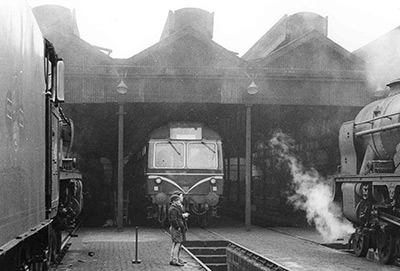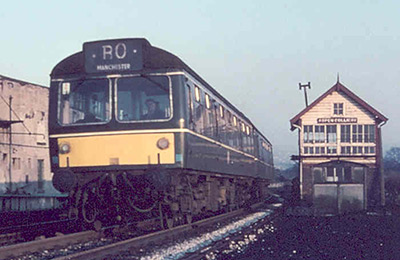Class 112/3 Cravens 2-car DMUs
Liveries
Green with whiskers
They were delivered in lined green with whiskers, red bufferbeam, white tyres and a grey roof.
The image shows a hydraulic set sitting in Accrington steam maintenance shed on Friday 6th May 1960. DH Dyson.
Green with yellow panel
In 1962 yellow panels began to replace the whiskers to provide better visibilty of oncoming trains.
The image shows a hydraulic unit passes Church Colliery Signal box in it's way to Manchester. DH Dyson.
Rail Blue with small yellow panel
Some did appear in this early blue livery variation in 1967. The BR arrows would be on the cab door, and the vehicle numbers would be 3" high. They would have red bufferbeams, but not the white cab roof domes that some classes would.
As with many classes, mixed livery sets in the changeover era were not uncommon, one vehicle in blue and one still in green. This image on flickr shows two sets, each with one vehicle still in green and the other in blue with a small yellow panel.
Rail Blue with yellow cab doors
Another livery changeover period experiment was a full yellow end with the cab doors also painted yellow which was applied to at least one Class 113 vehicle — see the rear vehicle in the image below. See also the rear vehicle on the image on page 12 of the book "Heyday of the DMUs".
Rail Blue with full yellow ends

In 1967 all blue livery with full yellow ends became the norm. This was not long before all the 112/3 vehicles were withdrawn, and there was still tremendous variety in the location of the BR arrows and location of the numbers. In this image on flickr, with three vehicles in view, two have the BR arrows on the cab door, one has it under the front passenger sidelight. The vehicles numbers are 3" high (4" would become standard) and the vertical location on the bodyside varies on both the vehicles they can be seen on.
Summary
Description
Drivers Instructions & Works Photos
Numbering
Liveries
Operations
Non-Passenger Use
Images
No vehicles were preserved.
Thanks to Andrew Dyson for additional information.




